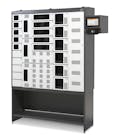Growing internal employee theft crisis creates havoc for major retailers
The 25th Annual Retail Theft Survey has just been released by Jack L. Hayes International and the results are as frightening for consumers as they are the retailers themselves.
Following an alarming trend from last year, the statistics on outside shoplifting and internal employee theft rose again in 2012 creating a potential firestorm that will impact the retailer’s bottom line and the cost of goods to their consumers.
The survey featured 23 of the country’s largest retail companies with 18,900 stores and over $596 billion in 2012 retail sales. Just these 23 major retailers alone apprehended over 1.1 million shoplifters and dishonest employees and recovered more than $189 million from these thieves in 2012, according to the annual retail survey. That is more than an 18 percent increase in recovered dollars over last year.
In 2012, shoplifting apprehensions increased 7.4 percent and the recovery dollars from shoplifters increased an amazing 22.7 percent. Dishonest employee apprehensions and recovery dollars also increased in 2012 - 5.5 percent and 7 percent respectively, according to Mark Doyle, president of Hayes International, the leading loss prevention and inventory shrinkage control consulting firm in the United States.
Despite the increase in the crime of shoplifting itself, it’s the internal threat from dishonest employees that shocks and worries Doyle most. The statistics related to employee theft are staggering and certainly a huge challenge for loss prevention professionals.
According to the survey, 71,095 dishonest employees were apprehended in 2012, which was up 5.5 percent from 2011. Retailers recovered over $50 million from these employees, which was also more than in 2011. The data shows that one out of every 40 employees stole from their retail employer in 2012, and on average, dishonest employees steal approximately 5.5 times the amount of retail goods than true shoplifters.
“Employee theft is perceived by many to be the most severe problem facing our industry today! Many people often think of theft and abuse in companies as being isolated acts, which in themselves cost an organization little. Unfortunately, this is untrue,” stresses Doyle, who adds that each year hundreds of thousands of employees are caught stealing from their employers and co-workers. “It is also not true that most employees are caught stealing inexpensive items such as pens, pencils, and paper clips from their employers. Over the years, Hayes International has witnessed a steady and significant rise in this serious problem.”
“The motivation for these thefts is really a personal issue by each dishonest employee. It could be a way to get back at the company for not getting a raise or promotion they thought they deserved or not feeling appreciated,” says Doyle. “Usually employees will rationalize their theft in their own minds. The motivation could be strictly monetary - the employee needs money for something (i.e. gambling debt, medical bills, drugs, etc.) and feels or rationalizes that theft is the only way to obtain it. Remember a dishonest employee is in the store or warehouse for 20, 30, 40 hours a week and knows the company's internal controls. Many times these employees will bide their time waiting for a breakdown in controls to take advantage of a situation. On the other hand, a shoplifter may be in the store for a matter of minutes.”
The survey asked participating companies to list some of the factors they believe have influenced the increase in both employee theft and shoplifting. When it comes to internal theft, retailers cite several major reasons they feel employees steal. Those factors are:
• Economic conditions are not getting better
• Lack of resources to help focus more and put a higher priority towards dishonest employees
• Lack of process controls and exception reporting capabilities
• Increased abuse of loyalty programs
• Weak detection strategies
• More part-time employees and less store supervision
While Doyle and his group agree with some of their retailers as to the root cause of increasing insider theft, they believe there are several key stumbling blocks facing harried LP staffs who hope to curtail this threat. Some of the most crucial issues include ineffective pre-employment screening or total lack of background checks, lower management staffing that leads to less employee supervision, an open and easy market place for selling stolen goods, and finally, a decline in personal honesty.
“The first step to controlling internal theft starts at the point-of-hire; do not hire the 'bad apple,'" says Doyle. “Some retailers, in an effort to reduce their costs, have lowered their pre-screening requirements and are now hiring more ‘questionable’ employees. Anytime statistics show one out of every 40 employees is actually caught stealing by their employer, there has to be some type of breakdown in the pre-employment screening process.”
Doyle admits that there are also so many more avenues for employees to quickly and easily sell stolen merchandise. “This easy access to a much larger audience for stolen goods has resulted in more theft by those dishonest employees looking for quick cash.”
And Doyle is not shy about pointing the finger at society’s current ills having a cause and effect.
“There are more dishonest people throughout the nation today, and this decline in personal honesty is taking its toll. Almost daily we hear of business, government, law enforcement, celebrities, sports figures, and even church leaders being caught up in questionable activities,” he chides. “Such events make it easier for borderline employees to steal and to rationalize their theft acts. In addition, the part-time workforce is growing, and it is not uncommon to find that many such workers have less loyalty to their employer, and are more apt to take advantage of opportune circumstances.”
“When it comes to employee theft deterrents, a thorough pre-employment screening process including, reference checks, honesty testing, SSN trace/verification, criminal background checks, and drug testing is most important. Money spent up-front in the screening process to identify quality employees will result in savings from reduced turnover and losses,” says Doyle.
He also stresses that companies must have an adequate system of internal controls, and audit to ensure consistent compliance to company policies and procedures. Loss prevention training and awareness programs, including a reward program for employees who report dishonest activities, are also important.
“We have found creating and maintaining a climate of honesty within the company is of utmost importance in controlling employee theft. Employees must feel valued, appreciated, and there should be no double standards among employees,” Doyle concludes. “Employees must realize through word and deed that honest and ethical behavior starts at the top and is expected of all employees.”



